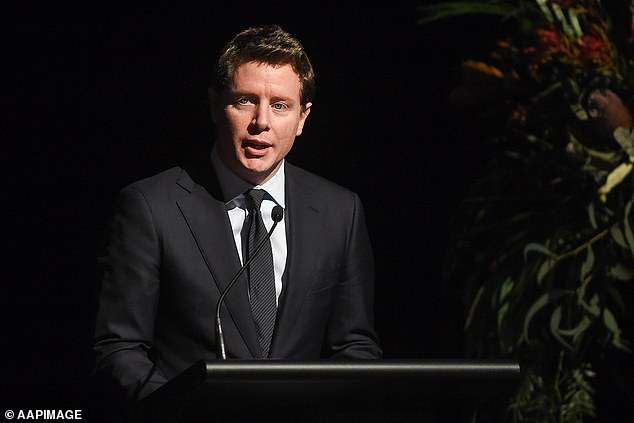Barefoot Investor Scott Pape has delivered a brutal reality check for homeowners, urging Aussies to ditch their current bank if they’re paying more than 5.68 per cent on their mortgage.
Pape said while the big banks battle it out with flashy rewards like CBA offering 300,000 Qantas frequent flyer points, the real deal could be slipping right through your fingers.
‘Which sounds amazing… until you realise that 300,000 points is worth, at best, $3,000, or at worst, a TV on the Qantas rewards website,’ he said in his latest column.
‘Meanwhile, ANZ and others are just offering cold hard cash, $2,000 to $4,000, to lure new customers away from brokers and through their own doors.’
Pape said Macquarie Bank is signing up a staggering 4 in 10 mortgages with customers drawn to its simple applications, transparent pricing and fast approvals.
However, he warned Macquarie, nicknamed the Millionaires’ Factory, was jacking up rates once they had ‘pinned’ customers.
‘Macquarie didn’t get the nickname the “Millionaires Factory” by playing nice forever.
‘Once they’ve got you pinned, they’ll go straight for your crown jewels – in this case, by jacking up the rates.’

If you’re paying more than 5.68 per cent interest rate on your home loan you should negotiate a better deal and save at least a few grand according to Barefoot Investor Scott Pape (pictured)
He recommended customers shop around for the best rate, which, according to ASIC’s MoneySmart, was currently 5.68 per cent for the average home loan for owner-occupiers.
‘If you’re paying more than that, and you’re in decent financial shape, you should be able to negotiate a better deal and save at least a few grand,’ he said.
‘So the next time you find yourself on the throne, open your bank app and check your rate. If you’re paying over the odds, find the negotiation script in my book (it’s generally found in most Aussie bathrooms), or just get ChatGPT to write you one.’
New research from Roy Morgan shows 1.4million mortgage holders – or 27.9 per cent – were ‘at risk’ of mortgage stress in the three months to August 2025, down just 0.5 percentage points from June.
The proportion of Australians struggling with repayments has remained above 25 per cent since February 2023, despite three interest rate cuts this year.
Since February, the Reserve Bank has lowered rates by 0.25 percentage points on three occasions, trimming more than $270 from monthly repayments on an average $600,000 loan.
The number of Australians considered ‘extremely at risk’ has climbed to 915,000, well above the long-term average of the past decade.
Roy Morgan chief executive Michele Levine said that while the RBA’s August rate cut eased some pressure, further reductions are needed to meaningfully lower mortgage stress.

Pressure is mounting on RBA boss Michele Bullock to cut the cash rate at the November meeting
Barefoot Investor’s script on how to get a better home loan rate
You: Hello, my account number is ______. I’ve been with you for ___ years, but I’ve applied to refinance with UBank. Their rate is ____ per cent, which is a full ___ per cent cheaper than you’re charging me. Given our longstanding relationship, I’d like you to match the offer—or send me the forms I need to switch to UBank.
Bank rep: One moment, please. (You’re bluffing, of course. However, the bank’s sales team have strict targets, backed by incentives, that they have to meet—one of which is giving profitable customers discounts to stop them leaving.)
Bank rep: We can’t match the rate you have quoted. However, we understand you are a valuable customer, so we would like to offer you a 0.15 per cent discount.
You: That’s not good enough. I’ve already got conditional approval … so in order to stay I need at least a 0.5 per cent discount. Could you please speak to your supervisor? I’m happy to wait.
Bank rep (a full six minutes later): On reviewing your case, we can offer you that 0.5 per cent discount on your current rate.
You: Brilliant! Please send me an email confirming the new rate and confirming that it will be applied as of start of business tomorrow.
<!- – ad: https://mads.dailymail.co.uk/v8/us/news/none/article/other/mpu_factbox.html?id=mpu_factbox_1 – ->
Advertisement
However, she warned that while cutting interest rates can ease mortgage stress in the short term, it can also create new pressures over time – as cheaper borrowing often drives up house prices and household debt.
‘As general interest rates are lowered, new buyers entering the market are able to borrow more money for larger loans to buy the best house they can afford at that time,’ she said.
‘And this, in turn, leads to a subsequent increase in mortgage stress due to the larger size of the average loan.’
Ms Levine said unemployment is the key factor that has the largest impact on income and mortgage stress.
Australia’s unemployment rate climbed to 4.5 per cent in September, its highest level in nearly four years ,surprising economists.
Victoria recorded the highest unemployment rate at 4.7 per cent, while Queensland saw a slight fall to 4.2 per cent. NSW sits at 4.3 per cent.
The rise came despite a modest increase of 14,900 jobs and a lift in the participation rate to 67 per cent, suggesting underlying weakness in the job market.
CBA economist Belinda Allen said the softer labour market adds complexity to the interest rate outlook when the RBA meets next month.
‘This is a classic case of conflicting signals,’ she said.
‘Inflation has been a little stronger, consumer spending is rising, but employment growth has slowed more than expected.
‘Until the tension between inflation and the labour market is resolved, we expect the RBA to remain cautious.’
